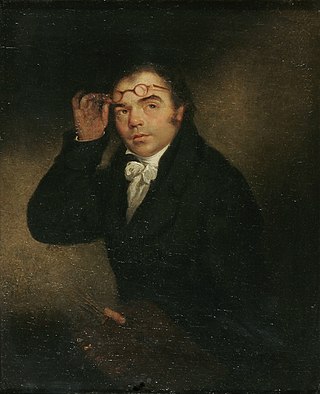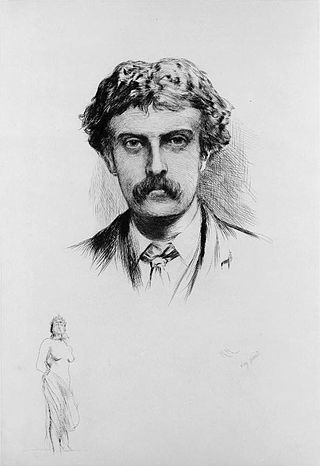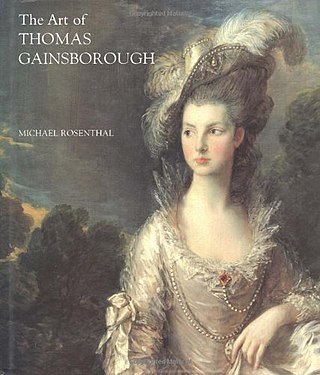
Thomas Gainsborough was an English portrait and landscape painter, draughtsman, and printmaker. Along with his rival Sir Joshua Reynolds, he is considered one of the most important British artists of the second half of the 18th century. He painted quickly, and the works of his maturity are characterised by a light palette and easy strokes. Despite being a prolific portrait painter, Gainsborough gained greater satisfaction from his landscapes. He is credited as the originator of the 18th-century British landscape school. Gainsborough was a founding member of the Royal Academy.

Joseph Mallord William Turner, known in his time as William Turner, was an English Romantic painter, printmaker and watercolourist. He is known for his expressive colouring, imaginative landscapes and turbulent, often violent marine paintings. He left behind more than 550 oil paintings, 2,000 watercolours, and 30,000 works on paper. He was championed by the leading English art critic John Ruskin from 1840, and is today regarded as having elevated landscape painting to an eminence rivalling history painting.

John Crome, once known as Old Crome to distinguish him from his artist son John Berney Crome, was an English landscape painter of the Romantic era, one of the principal artists and founding members of the Norwich School of painters. He lived in the English city of Norwich for all his life. Most of his works are of Norfolk landscapes.

Sir John Everett Millais, 1st Baronet was an English painter and illustrator who was one of the founders of the Pre-Raphaelite Brotherhood. He was a child prodigy who, aged eleven, became the youngest student to enter the Royal Academy Schools. The Pre-Raphaelite Brotherhood was founded at his family home in London, at 83 Gower Street. Millais became the most famous exponent of the style, his painting Christ in the House of His Parents (1849–50) generating considerable controversy, and he produced a picture that could serve as the embodiment of the historical and naturalist focus of the group, Ophelia, in 1851–52.

John Constable was an English landscape painter in the Romantic tradition. Born in Suffolk, he is known principally for revolutionising the genre of landscape painting with his pictures of Dedham Vale, the area surrounding his home – now known as "Constable Country" – which he invested with an intensity of affection. "I should paint my own places best", he wrote to his friend John Fisher in 1821, "painting is but another word for feeling".

George Stubbs was an English painter, best known for his paintings of horses. Self-trained, Stubbs learnt his skills independently from other great artists of the 18th century such as Reynolds and Gainsborough. Stubbs' output includes history paintings, but his greatest skill was in painting animals, perhaps influenced by his love and study of anatomy. His series of paintings on the theme of a lion attacking a horse are early and significant examples of the Romantic movement that emerged in the late 18th century. He enjoyed royal patronage. His painting Whistlejacket hangs in the National Gallery, London.
The Norwich School of painters was the first provincial art movement established in Britain, active in the early 19th century. Artists of the school were inspired by the natural environment of the Norfolk landscape and owed some influence to the work of landscape painters of the Dutch Golden Age such as Hobbema and Ruisdael.

Cecil Gordon Lawson was a British landscapist and illustrator.

Paul Sandby was an English map-maker turned landscape painter in watercolours, who, along with his older brother Thomas, became one of the founding members of the Royal Academy in 1768.

Samuel Colman was an American painter, interior designer, and writer, probably best remembered for his paintings of the Hudson River.

James Sidney Edouard, Baron Ensor was a Belgian painter and printmaker, an important influence on expressionism and surrealism who lived in Ostend for most of his life. He was associated with the artistic group Les XX.

John Trevor Hayes was a British art historian and museum director. He was an authority on the paintings of Thomas Gainsborough.

John Laporte was an English landscape painter and etcher, who worked in and around London, England.

Thomas Barker or Barker of Bath, was a British painter of landscape and rural life.

Michael J. Rosenthal is emeritus professor of the history of art at the University of Warwick. He is a specialist both in British art and culture of the eighteenth and early nineteenth centuries, and the arts of early colonial Australia.

Wooded Landscape with a Herdsman Seated is an oil painting by Thomas Gainsborough, from 1748. It is in the collection of Gainsborough's House.

Hugh Graham Belsey, MBE, is a British art historian who is an authority on the art of Thomas Gainsborough. For 23 years he was the curator of Gainsborough's House in Sudbury. His most recent contribution to Gainsborough scholarship is his catalogue raisonné of Gainsborough's portraits published in February 2019 by the Yale University Press for the Paul Mellon Centre for Studies in British Art.

Thomas Gainsborough was the first British artist to employ cottages as a major subject, in what has become known as his "Cottage Door" paintings, painted during the final decades of his life; and was in the vanguard of a late 18th century fad of interest in them.

Maria, Lady Eardley is an oil on canvas by the English artist, Thomas Gainsborough, painted around the time of her marriage in 1766, according to British art historian, Ellis Waterhouse, in “Preliminary Check List of Portraits by Thomas Gainsborough,” The Volume of the Walpole Society 33 : 34. It has been in the collections of Nationalmuseum in Stockholm since 1966.




















